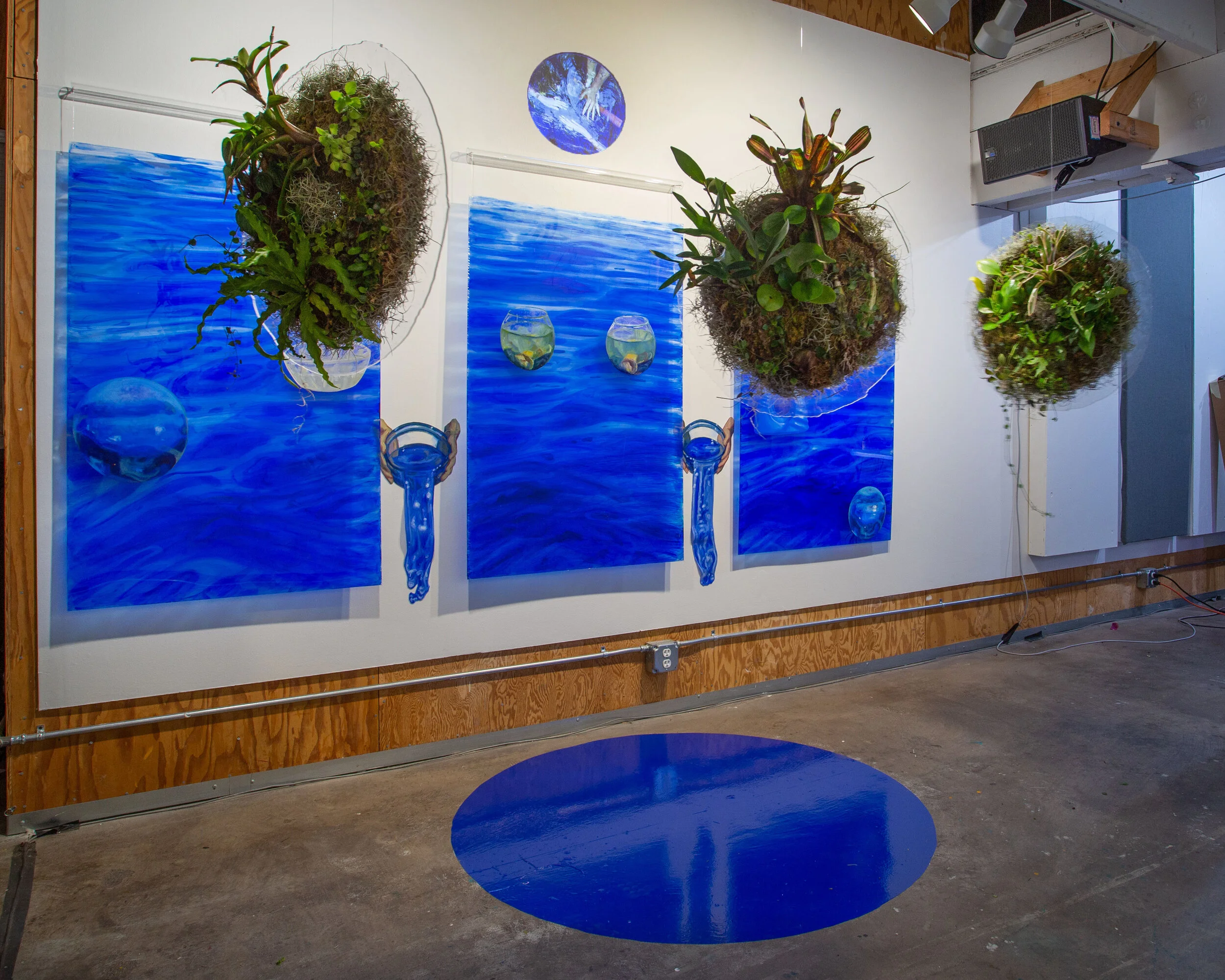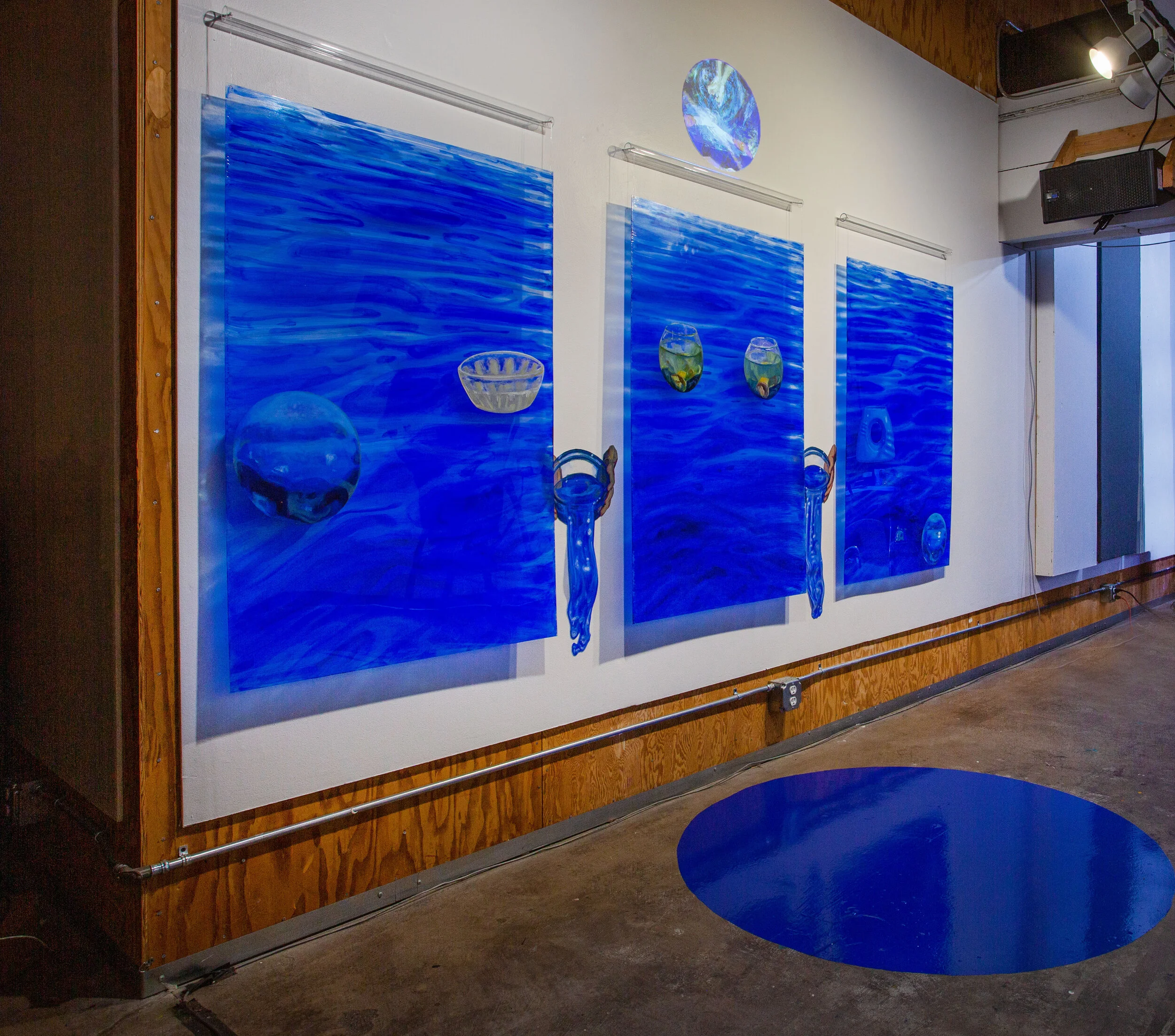Methods for Descrying (The Water Shapes the Plants and the Plants Shape the Water) (2022)
Plants, moss, oil paint handmade from flowers and algae, glass, metal, flowers, rocks,
Wonzimer Gallery, Los Angeles, 2022
The dominating timescape fabricated within westernized capitalist infrastructure is the linear-progressive one, the one Ursula Le Guin calls“time’s killing arrow mode of the techno-heroic”, by which progress rides an insatiable growth on the wheels of goal-oriented acceleration that modernity has evolved with. The techno-heroic timescape is a hunger for a material permanence that can outlive death (a race against the clock). Disrupting death means disrupting the cyclical nature that allows death to bring new life. The opposite of this is viriditas. Viriditas (Latin, literally "greenness," ) is a Latin word meaning vitality, fecundity, lushness, or growth. “Viriditas” is a term used by 12th century polymath healer, Hildegard of Bingen, as the self-regenerating power in plants analogous to the intrinsic healing power of human beings to renew their own future. The notion of Viriditas is induced here both as the comparative expression of the force of renewal within plants to that within humans as well as the actualization of such renewal put into motion by the interaction between humans and plants. This kind of time is cyclical time, the kind of time that sees the future of life that comes from death. Cyclical metabolism is the generous taste of impermanence: Earth renews itself by crafting compost from all that is loss into all that can be cultivated. Thinking with this kind of timescape means awareness of the present processes that impregnate what we will leave behind beyond us. These cycles of death take place even within our inner most selves…can we dream with our metabolisms? Along the meridians of process and release; a space of time where healing befriends impermanence…
//
Water scrying is a method of divination by which one gazes into water in a meditative state, employing intuition to pull out images that arise in sensory communion as guidance for the unknown. The word “scrying” comes from “descry”, which means seeing something unclear by looking carefully, or to catch sight of. Unlike other forms of divination that provide counsel for the future in the form of tangible prescriptions, scrying is more of an opening - a practice of how one senses their environment. Scrying is a practice of listening to spaces outside of our conventional thoughtscape. Rational epistemology suspends in comatose in order to make space for the watery, sensory openness that invites in guidance. The reflective surface dances into shapeforms that resonate to stillness in the mind. When technologies sense for us, forecast for us, we must cultivate our resonating senses to better understand how a future is brought into being. Divination by scrying does not so much look outwards toward the future, but inwards to better understand one’s relationship with the future.
~~~
Preliminary conditions include: to be still, still to be open, open to be able to sense…
Softly gaze into a body of earth’s body water and still your thoughts, pause the itching desire for rational explanation.. Inhale and look face to face with your heart and ask what is really, truly needed. Exhale and unfocus the sharpness of the eyes, give attention to the dancing shapeforms. Inhale and ask for guidance. Exhale and listen until it comes. This is a cultivation of listening that can open up other forms of listening. Forms to cope, to heal, to endure, to find resonance as we shimmer between worlds.
~~~
We, geological force, with footprints
longer than
our own consciousness.
Through a time-ache, asked:
what does more-than-human time feel like?
To feel differently about time; time-beyond our
episteme-shaped human subjectivities
inside subtlety of deep listening outside of ourselves.
The plants tell a story within their roots
and through their being
of healing through “Viriditas”:
regeneration shaped through recursion
a continuing birthed from world-cinders as
here, in this l o n g m o m e n t , we are in threads of a new world
The color of this morning quickly fading.
To see the color of the plants,
look through the water
Water of the mind -
the precognitive cthonic substrate,
the nonthinking to thought’s recalibration
the rhythmic veins, the venous rhythms of Earth
the water of the mind
is resonance.
Swelling with sense,
stretching presence to memory
remembrance of how to make sense.
Recent scientific headlines read: “the water is losing its memory!” By this the scientists mean:
the way we read water with technological instruments to forecast the future
is becoming nebulous due to the impeding repercussions of anthropogenic climate change
(senses blocked).
When our sensing is handed over to digital technologies /extended-selves
how are our senses /extended-selves
compromised? Saturating the forecasting.
Divination is a method of being so present
with your environmental mesh
that you can better understand
how a future is brought into being
To unpredict the future
(our cosmologies are co-written with our practices).
Kisses of osmosis lingering between
translation and lost in translation.
Water shapes the plants
shapes the way we hear the plants
plants shape the way we listen, way we heal
Can you hear them crying out to be heard?
not with your ears
We, too, crying out for healing at all times and places
The water offered nonthinking as
point of departure
…the space between here and there is one of dreaming
Present Topography
Indexical Santa Cruz, 2021
photos by Suzy Poling
“The geontological division of Life and Nonlife is not merely a division but an opportunity for a set of further divisions as maneuver... Capitalism depends on creating by destroying and then erasing the connections between the material wastes it leaves behind and the glimmering oasis of privilege this waste affords. [Anti-colonial worlds need] a constant attentiveness to the adjustments and innovations necessary to keep human and nonhuman forms in a co-constituting relation was a creative core to the ancestral present.“- Elizabeth Povinelli
There is an urgency in our time, to begin to reconstruct new narratives of connection to our acentered planet and our entangled present. Neither a nostalgic past of a pristine habitat that once was, nor a utopian, techno-fixed future of what could be, but instead, a present as continual processes of re-relating to landscape and nonhuman life. We must destabilize congealed perspectives which still normalize nature as something “out there”, or as a “sublime retreat”, so as to realize there is no “out there”. Wherever we are, we are affecting and being affected by the planetary, that which is both of us and beyond us, but is never reducible to one or the other. Present Topography explores how we might reorient within the present, while doing so in a state of attentive presence. Living in the age of an attention economy, where our presence is constantly capitalized on in a way which hinders our senses of receptivity, presence is of urgency to be able to deeply listen and respond to effects on our internal and external environment. Considering landscape not as something “out there”, but as something that can move and dance, at all times and places, within our inner experience, where new habits can assist us to resituate exteriority into our immediate, inner psyche. The installation exhibits painted ritual objects and sacred shapes entangled with landscapes that are never wholly contained by their physical locations, illustrating how preexisting knowledge can be deployed to re-enchant our relationship to the “nonliving” world within our daily practices. Ritual practice always involves a mutability which erodes bodily edges, extending the sensorium in a way which defies “geontopower”, the governance of existence through the imposition of divisions between life and nonlife, which lies at the heart of anthropocentric colonial ordering. Present Topography redeploys space and time as a suture of this rupture, grounded in enduring presence.














